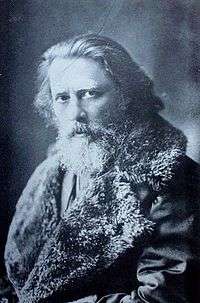Mihály Zichy

Mihály Zichy (Hungarian pronunciation: [ˈmihaːj ˈzit͡ʃi]; German: Michael von Zichy; October 15, 1827 in Zala, Hungary – February 28, 1906 in St. Petersburg, Russia) was a Hungarian painter and graphic artist.
Biography
Mihály Zichy was a significant representative of Hungarian romantic painting. During his law studies in Pest from 1842, he attended Jakab Marastoni's school as well. In Vienna he was Waldmüller's pupil in 1844. "Lifeboat", his first major work, comes from this time. On Waldmüller's recommendation, he became an art teacher in St. Petersburg. He swore allegiance to freedom by painting the portrait of Lajos Batthyány, the first Hungarian prime minister, in 1849. From 1850 onwards, he worked as a retoucher, but he also did pencil drawings, water colours and portraits in oil. His erotic drawings have a particular warm intensity in which both members of the couple seem equal partners. The series on the Gatchina hunting ordered by the Russian tsar raised him to a court artist. He founded a society to support painters in need. "Autodafé" on the horrors of Spanish inquisition was painted in 1868. He travelled around Europe in 1871, and settled down in Paris in 1874.
He painted "Queen Elisabeth Laying Flowers by the Coffin of Ferenc Deák" to a commission from Treffort. "Drinking Bout of Henry III", his next large-scale picture, came in 1875. "The Victory of the Genius of Destruction" painted for the Paris Exhibition was banned by French authorities because of its daring antimilitarist message. He left Paris in 1881 and returned to St. Petersburg after short stays in Nice, Vienna and his native Zala.
In 1881 he was in Tbilisi, Georgia, where he started working on illustrations for "The Knight in the Panther's Skin" at the request of the Georgian intelligencia. He painted 35 pictures in total. The publishing commission of the work of "The Knight in the Panther's Skin" chose 27 pictures to be included in the publication. The painter refused to take payment for the works, so impressed was he by the poem itself. Instead, he gifted the works to the Georgian people.
From this time onwards, he became mostly engaged in illustration work ("The Tragedy of Man" by Madách, 1887, and twenty-four ballads of János Arany, 1894–98).
 Lovers Embrace in Ink by Mihály Zichy
Lovers Embrace in Ink by Mihály Zichy Shota Rustaveli presents his poem to Queen Tamar 1880s
Shota Rustaveli presents his poem to Queen Tamar 1880s "The Triumph of the Genius of Destruction"
"The Triumph of the Genius of Destruction" "Lifeboat"
"Lifeboat"
References
- Ilona Berkovits, Zichy, Mihály. Leben und Werk, Akadémiai Kiadó, Budapest 1964.
External links
| Wikimedia Commons has media related to Mihály Zichy. |
- Mihály Zichy's Illustrations for The Tragedy of Man
- Sós Antikvárium: Mihály Zichy's Illustrations for Liebe (Hungarian)
- http://www.huffingtonpost.com/2014/05/12/mihaly-zichy_n_5269182.html